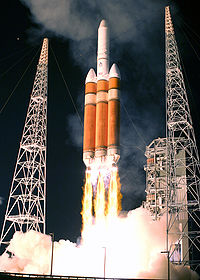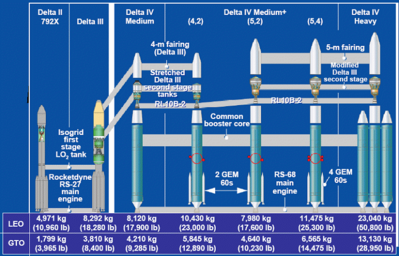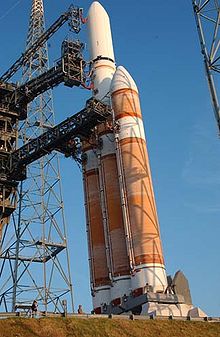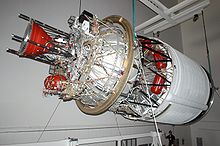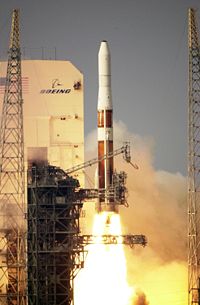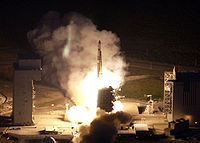- Delta IV
-
Delta IV (Delta 9000) 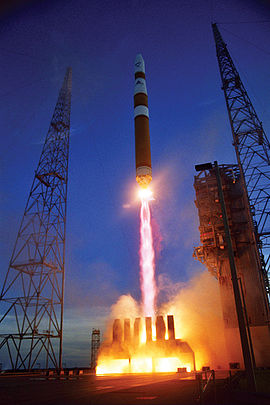
Delta IV Medium launch carrying DSCS III-B6Function Orbital launch vehicle Manufacturer Boeing IDS
United Launch AllianceCountry of origin United States Size Height 63 - 72 m (206 - 235 ft) Diameter 5 m (16.4 ft) Mass 249,500 - 733,400 kg (550,000 - 1,616,800 lb) Stages 2 Capacity Payload to LEO 8,600 - 22,560 kg (18,900 - 49,740 lb) Payload to
GTO3,900 - 12,980 kg (8,500 - 28,620 lb) Launch history Status Active Launch sites SLC-37B, Cape Canaveral
SLC-6, Vandenberg AFBTotal launches 17
Medium: 3
Medium+ (4,2): 8
Medium+ (5,4): 1
Heavy: 5Successes 16
Medium: 3
Medium+ (4,2): 8
Medium+ (5,4): 1
Heavy: 4Partial failures 1 (Heavy) Maiden flight Medium: 11 March 2003
Medium+ (4,2): 20 November 2002
Medium+ (5,4): 6 December 2009
Heavy: 21 December 2004Boosters (Medium+ Variants) - GEM 60 No. boosters Medium: 0; M+4,2: 2; M+5: 2 or 4 Engines 1 Solid Thrust 826.6 kN (185,817 lbf) Specific impulse 275 sec Burn time 90 seconds Fuel Solid Boosters (Heavy) - CBC No boosters 2 Engines 1 RS-68 Thrust 3,312.8 kN (744,737 lbf) Specific impulse 410 sec Burn time 249 seconds Fuel LH2/LOX First stage - CBC Engines 1 RS-68 Thrust 3,312.8 kN (744,737 lbf) Specific impulse 410 sec Burn time 259 seconds Fuel LH2/LOX Second stage Engines 1 RL10-B-2 Thrust 110 kN (24,740 lbf) Specific impulse 462 sec Burn time 850 - 1,125 seconds Fuel LH2/LOX Delta IV is an active expendable launch system in the Delta rocket family. Delta IV uses rockets designed by Boeing's Integrated Defense Systems division and built in the United Launch Alliance (ULA) facility in Decatur, Alabama. Final assembly is completed at the launch site by ULA.[1] The rockets were designed to launch payloads into orbit for the United States Air Force Evolved Expendable Launch Vehicle (EELV) program and commercial satellite business. Delta IV rockets are available in five versions: Medium, Medium+ (4,2), Medium+ (5,2), Medium+ (5,4), and Heavy, which are tailored to suit specific payload size and weight ranges. Delta IV was primarily designed to satisfy the needs of the U.S. military.
The rockets are assembled at the Horizontal Integration Facility for launches from SLC-37B at Cape Canaveral, and in a similar facility for launches from SLC-6 at Vandenberg AFB.
Contents
History
The Delta IV entered the space launch market at a period when global capacity was already much higher than demand. Furthermore, as an unproven design it has had difficulty finding a market in commercial launches, and the cost to launch a Delta IV is somewhat higher than that for competing vehicles. In 2003, Boeing pulled the Delta IV from the commercial market, citing low demand and high costs. In 2005, Boeing stated that it may return the Delta IV to commercial service; however as of 2006[update] no further announcements have been made regarding this.[2] All but one of the first launches have been paid for by the U.S. Government, with a cost of between $140 million and $170 million.
Comparable rockets: Atlas V - Ariane 5 - Chang Zheng 5 - Angara - H-IIB - Proton - Falcon 9
Vehicle description
Delta IV first stage
The first stage of a Delta IV consists of one, or in the Heavy variety three, Common Booster Cores (CBC) powered by a Rocketdyne RS-68 engine. Unlike many first-stage rocket engines, which use solid fuel or kerosene, the RS-68 engines burn liquid hydrogen and liquid oxygen. The CBC was the first large rocket to lift off using this propellant combination exclusively.[citation needed]
In 2002 the RS-68 became the first large, liquid-fueled rocket engine designed in the U.S. since the Space Shuttle Main Engine (SSME) in the 1970s.[3] The primary goal for the RS-68 was to reduce cost versus the SSME. Some sacrifice in chamber pressure and specific impulse was made, hurting efficiency; however, development time, part count, total cost, and assembly labor were reduced to a fraction of the SSME, despite the RS-68's significantly larger size. Typically, the RS-68 runs at 102% rated thrust for the first few minutes of flight, and then throttles down to 58% rated thrust before main engine cutoff.[4] On the Heavy variant, the core CBC's engine throttles down to 58% rated thrust around 50 seconds after liftoff, while the strap-on CBCs remain at 102%. This allows the core CBC to conserve propellant and burn longer. After the strap-on CBCs separate, the core CBC's engine throttles back up to 102% before throttling back down to 58% prior to main engine cutoff.[5]
The RS-68 engine is mounted to the lower thrust structure of the vehicle by a four-legged (quadrapod) thrust frame, and enclosed in a protective composite conical thermal shield. Above the thrust structure is an aluminum isogrid (a grid pattern machined out of the inside of the tank to reduce weight) liquid hydrogen tank, followed by a composite cylinder called the centerbody, an aluminum isogrid liquid oxygen tank, and a forward skirt. Along the back of the CBC is a cable tunnel to hold electrical and signal lines, and a tube to carry the liquid oxygen to the RS-68 from the tank. The CBC is of a constant, 5-meter, diameter.[3]
Delta Cryogenic Second Stage
The upper stage of the Delta IV, or DCSS, is nearly identical to that of the Delta III,[citation needed][clarification needed] however the tanks are friction stir welded and either stretched (in 4-meter variants), or have a larger diameter (5-meter variants). The second stage is powered by a Pratt & Whitney RL-10B2 engine, which features an extendable carbon-carbon nozzle to improve specific impulse. Depending on variant, two different interstages are used to mate the first and second stages. A tapering interstage which narrows down from 5-meters to 4-meters in diameter is used on 4-meter variants, where a cylindrical interstage is used on 5-meter variants. Both interstages are built from composites.[6]
The L-3 Communications Redundant Inertial Flight Control Assembly (RIFCA) guidance system used on the Delta IV is common to that carried on the Delta II, although the software is different because of the differences between the Delta II and Delta IV. The RIFCA features six ring laser gyroscopes and accelerometers each, to provide a higher degree of reliability.[7]
Payload encapsulation
To encapsulate the satellite payload, a variety of different payload fairings are available. A stretched Delta III 4-meter composite payload fairing is used on 4-meter variants, where an enlarged, 5-meter composite fairing is used on 5-meter variants. A longer version of the latter is standard on the Heavy variant, and a Boeing-built Titan-IV derived 5-meter, aluminum isogrid payload fairing is also available for the Heavy.
At over 63 meters in length, the Delta IV has been the tallest rocket in active use since its[when?] introduction.[citation needed]
Variants
Delta IV Small
During the Delta IV's development, a Small variant was considered. This would have featured the Delta II second stage, an optional Thiokol Star 48B third stage, and the Delta II payload fairing, all atop a single CBC.[8] The Small variant was dropped by 1999.[9][10] This was probably because the Delta II has a similar payload capability.
Delta IV Medium
The Delta IV Medium (Delta 9040) is the most basic Delta IV. It features a single CBC and a modified Delta III second stage, with 4-meter liquid hydrogen and liquid oxygen tanks and a 4-meter payload fairing derived from the Delta III fairing.[citation needed] The Delta IV Medium is capable of launching 4,210 kg (9,285 lb) to geosynchronous transfer orbit (GTO).
The Delta IV Medium+ (4,2) (Delta 9240) is similar to the Medium, but uses two Alliant-built 1.5-m (60-in) diameter solid rocket strap-on Graphite-Epoxy Motors (GEM-60s) to increase payload capacity to 5,845 kg (12,890 lb) to GTO.
The Delta IV Medium+ (5,2) (Delta 9250) is similar to the Medium+ (4,2), but has a 5-m–diameter payload fairing for larger payloads and a modified second stage with a 5-meter liquid hydrogen tank and stretched liquid oxygen tank.[citation needed] Because of the extra weight of the larger payload fairing and second stage, the Medium+ (5,2) can launch 4,640 kg (10,230 lb) to GTO, less than the Medium+ (4,2).
The Delta IV Medium+ (5,4) (Delta 9450) is similar to the Medium+ (5,2), but uses four GEM-60s instead of two, enabling it to lift 6,565 kg (14,475 lb) to GTO.
Delta IV Heavy
The Delta IV Heavy (Delta 9250H) is similar to the Medium+ (5,2), except that it uses two additional CBCs instead of using GEMs. These are strap-on boosters which are separated earlier in the flight than the center CBC. The Delta IV Heavy also features a stretched 5-meter composite payload fairing.[11] An aluminum trisector (3 part) fairing derived from the Titan IV fairing is also available.[12] This was first used on the DSP-23 flight.
Capacity (separated spacecraft mass) of the Delta IV Heavy:
- geosynchronous transfer orbit (GTO) 13,130 kg (28,950 lb), more than any other currently available launch vehicle.[13]
- geosynchronous orbit (GEO) 6,275 kg
- escape orbit 9,306 kg
- C3 performance of 30 km²s−2: 5,228 kg
- C3 performance of 60 km²s−2: 2,521 kg
The Heavy's total mass at launch is approximately 733,000 kg, much less than that of the Space Shuttle (2,040,000 kg).
Future variants
Possible future upgrades for the Delta IV include adding extra strap-on solid motors to boost capacity, higher-thrust main engines, lighter materials, higher-thrust second stages, more (up to six) strap-on CBCs, and a cryogenic propellant cross feed from strap on boosters to the common core. These modifications could potentially increase the mass of the payload delivered to LEO to 100 tonnes.[11]
At one point NASA planned to use Delta IV to launch a Crew Exploration Vehicle.[14] But with the CEV changed from a winged spacecraft to an Apollo-like capsule with the Ares I launch vehicle, based on Space Shuttle components. After the change only the Delta IV's RS-68 engine was considered by NASA for the new cryogenically fueled Ares V rocket. Then on August 8, 2011 NASA announced that a Delta IV Heavy rocket will launch the Orion Multi-Purpose Crew Vehicle on an unmanned test flight, known as OFT-1, in July 2013.[15]
In 2009 The Aerospace Corporation reported to NASA results of study intended to determine the feasibility of modifying Delta IV to be human-rated for use in NASA human spaceflight missions. According to Aviation Week the study, "found that a Delta IV heavy [...] could meet NASA's requirements for getting humans to low Earth orbit."[16]
The possibility of an extra-heavy variant was indicated in a 2006 RAND Corporation study of national security launch requirements out to 2020,[17] which noted, "...only the Delta IV Heavy has the performance to lift the ten NSS launch requirements that require a heavy-lift capability... the production capacity for Delta IV, with one possible exception, can satisfy the entire projected NSS launch demand. The exception involves the requirement to increase the Delta IV Heavy lift capability to accommodate a single NRO (National Reconnaissance Office) payload. The best solution to this requirement is currently under study."
An upgrade of the Delta IV Heavy, using the higher-performance RS-68A engine, is under development with initial availability in early 2011. This upgrade is planned to provide a roughly 13% improvement in payload capability to GTO. The new RS-68A is also planned to be used throughout the entire Delta IV family, where at 106% thrust it will provide a roughly 7–11% improvement in GTO payload (although this higher power level may require structural changes; running the engine at the current 102% produces a smaller improvement but requires less modification).
Another possible upgrade to the Delta IV family is the creation of new variants by the addition of extra solid motors. One such modification, the Medium+(4,4), would pair the four GEM-60s of the M+(5,4) with the upper stage and fairing of the (4,2). This would theoretically provide a GTO payload of 7,500 kg (16,600 lb) and an LEO payload of 14,800 kg (32,700 lb). This is the simplest variant to implement and is available within 36 months of the first order. Two other possible versions, the Medium+(5,6) and (5,8), would add two or four extra GEM-60s to the (5,4) variant, respectively. These would provide significantly higher performance (up to 9,200 kg/20,200 lb to GTO for the M+(5,8)) but would require more extensive modifications to the vehicle, such as adding the extra attach points and changes to cope with the different flight loads. They would also require pad and infrastructure changes. The Medium+(5,6) and (5,8) can be available within 48 months of the first order.[18]
Launch sites
Delta IV launches occur from either of two rocket launch sites. On the East coast of the United States, Space Launch Complex 37 (SLC-37) at the Cape Canaveral Air Force Station. On the West coast, polar-orbit and high-inclination launches use Vandenberg Air Force Base's Space Launch Complex 6 (SLC-6) pad.
Launch facilities at both sites are similar. At the pad is a Mobile Service Tower (MST), which provides service access to the rocket and protection from the weather. There is a crane at the top of the MST, which allows the payload and GEM-60 solid motors to be attached to the vehicle. The MST is rolled away from the rocket several hours before launch. At Vandenberg, the launch pad also has a Mobile Assembly Shelter (MAS), which completely encloses the vehicle; at CCAFS, the vehicle is partly exposed near its bottom.
Beside the vehicle is a Fixed Umbilical Tower (FUT), which has two (VAFB) or three (CCAFS) swing arms. These arms carry electrical, hydraulic, environmental control, and other support functions to the vehicle through umbilical lines. The swing arms retract at T-0 seconds to prevent them from hitting the vehicle.
Under the vehicle is a Launch Table, with six Tail Service Masts (TSMs), two for each CBC. The Launch Table supports the vehicle on the pad, and the TSMs provide further support and fueling functions for the CBCs. The vehicle is mounted to the Launch Table by a Launch Mate Unit (LMU), which is attached to the vehicle by bolts that sever at launch. Behind the Launch Table is a Fixed Pad Erector (FPE), which uses two long-stroke hydraulic pistons to raise the vehicle to the vertical position after being rolled to the pad from the Horizontal Integration Facility (HIF). Beneath the Launch Table is a flame duct, which deflects the rocket's exhaust away from the rocket or facilities.
The Horizontal Integration Facility (HIF) is situated some distance from the pad. It is a large building that allows the Delta IV CBCs and second stages to be mated and tested before they are moved to the pad. The horizontal rocket assembly of the Delta IV are similar to the ones with the assembly of Soyuz launch vehicles; they are also assembled horizontally, unlike the current Space Shuttles, the past Saturn launch vehicles and the upcoming Ares I and Ares V, where they are assembled and rolled out to the launch pad entirely vertically.
Movement of the Delta IVs among the various facilities at the pad is facilitated by Elevating Platform Transporters (EPTs). These rubber-tired vehicles can be powered by either diesel engines or electric power. Diesel EPTs are used for moving the vehicles from the HIF to the pad, while electric EPTs are used in the HIF, where precision of movement is important.[19]
Vehicle processing
The Delta IVs are assembled using a process that Boeing claims reduces cost and expensive on-pad time. The CBCs are built in Boeing's factory in Decatur, Alabama. They are then loaded onto the roll-on/roll-off cargo vessel, and shipped to either launch pad. There, they are offloaded and rolled into a Horizontal Integration Facility (HIF), where they are mated with the second stages, which were shipped separately to the pad on the Delta Mariner. Also, in the HIF, the three CBCs of Heavy variant are mated to each other.
Various tests are performed, and then the vehicle is rolled horizontally to the pad, where the Fixed Pad Erector (FPE) is used to raise the vehicle to the vertical position, inside the MST. At this time, the GEM-60 solid motors, if any are required, are rolled to the pad and attached to the vehicle. After further testing, the payload (which has already been enclosed in its fairing) is transported to the pad, hoisted into the MST by a crane, and attached to the vehicle. Finally, on launch day, the MST is rolled away from the vehicle, and the vehicle is ready for launch.[20]
History
Recent history
The United States Air Force (USAF) continues to fund Delta IV engineering, integration and infrastructure through contracts with Boeing Launch Services (BLS). On August 8, 2008 the USAF Space and Missile Systems Center increased the "cost plus award fee" contract with BLS for $1,656 million to extend the period of performance through the end of FY09[update]. In addition a $557.1 million option was added to cover FY10.[21]
Delta IV launches
For more details on this topic, see List of Thor and Delta launches (2000–2009).List Date: March 12, 2011
No. Date/Time
(UTC)Type Serial-no. Startplace Payload Type of payload Orbit Outcome Remarks 1 2002-11-20
22:39Medium+(4,2) 293 CCAFS SLC-37B Eutelsat W5 Commercial communications satellite GTO Success First Delta IV launch 2 2003-03-11
00:59Medium 296 CCAFS SLC-37B USA-167 (DSCS-3 A3) Military communications satellite GTO Success First Delta IV Medium launch
First USAF EELV mission3 2003-08-29
23:13Medium 301 CCAFS SLC-37B USA-170 (DSCS-3 B6) Military communications satellite GTO Success 4 2004-12-21
21:50Heavy 310 CCAFS SLC-37B DemoSat [22] / 3CS-1 / 3CS-2 Demonstration payload GSO (planned) Partial failure 5 2006-05-24
22:11Medium+(4,2) 315 CCAFS SLC-37B GOES 13 (GOES-N) Weather satellite GTO Success 6 2006-06-28
03:33Medium+(4,2) 317 VAFB SLC-6 USA-184 (NROL-22) Reconnaissance satellite Molniya Success First Delta IV launch from Vandenberg[25] 7 2006-11-04
13:53Medium 320 VAFB SLC-6 USA-192 (DMSP F17) Military weather satellite SSO Success First Delta IV launch into a LEO/SSO 8 2007-11-11
01:50Heavy 329 CCAFS SLC-37B USA-197 (DSP-23) Missile Warning satellite GSO Success First Delta IV launch contracted by United Launch Alliance
Launch delayed due to damage to launch pad caused by a liquid oxygen leak[26]9 2009-01-18
02:47[27][28]Heavy 337 CCAFS SLC-37B USA-202 (NROL-26) Reconnaissance satellite GSO Success[29] 10 2009-06-27
22:51[30]Medium+(4,2) 342 CCAFS SLC-37B GOES 14 (GOES-O) Weather satellite GTO Success[31] 11 2009-12-06
01:47[32]Medium+(5,4) 346 CCAFS SLC-37B USA-211 (WGS-3) Military communications satellite GTO Success[32] First Delta IV Medium+ (5,4) launch 12 2010-03-04
23:57Medium+(4,2) 348 CCAFS SLC-37B GOES 15 (GOES-P) Weather satellite GTO Success[33] 13 2010-05-28
03:00Medium+(4,2) 349 CCAFS SLC-37B USA-213 (GPS IIF SV-1) Navigation Satellite MEO Success[34] 14 2010-11-21
22:58[27]Heavy 351 CCAFS SLC-37B USA-223 (NROL-32) Reconnaissance satellite GSO Success[35] 15 2011-01-20
21:10Heavy 352 VAFB SLC-6 USA-224 (NROL-49) Reconnaissance satellite LEO Success[36] First Delta IV Heavy launch from Vandenberg[36] 16 2011-03-11
23:38[27]Medium+(4,2) 353 CCAFS SLC-37B USA-227 (NROL-27) Reconnaissance satellite GTO Success[37] 17 2011-07-16
06:41Medium+(4,2) 355 CCAFS SLC-37B USA-231 (GPS IIF SV-2) Navigation Satellite MEO Success[38] For 2011 and planned launches, see:
List of Thor and Delta launches (2010–2019)Notable past launches
The first payload launched with a Delta IV was the Eutelsat W5 communications satellite. The launch vehicle was a Medium+ (4,2) variant, launched from Cape Canaveral. It carried the communications satellite into geostationary transfer orbit (GTO) on November 20, 2002.
Heavy Demo was the first launch of the Heavy variant in December 2004 after significant delays due to bad weather. Due to cavitation in the propellant lines, sensors registered depletion of propellant. The strap-on, and later core CBC engines shut down prematurely, even though sufficient propellant remained to continue the burn as scheduled. The second stage attempted to compensate for the under-burn, until it ran out of propellant. This flight was a test launch carrying a payload of:
- DemoSat – 6020 kg; an aluminum cylinder filled with 60 brass rods – planned to be carried to GEO; however due to the sensor faults, the satellite did not reach this orbit.
- NanoSat-2, carried to low Earth orbit (LEO) – a set of two very small satellites of 24 and 21 kg, nicknamed Sparky and Ralphie – planned to orbit for one day. Given the under-burn, the two most likely did not reach a stable orbit.[39]
NROL-22 was the first Delta IV launched from SLC-6 at Vandenberg Air Force Base (VAFB). It was launched aboard a Medium+ (4,2) in June 2006 carrying a classified satellite for the U.S. National Reconnaissance Office (NRO).
DSP-23 was the first launch of a valuable payload aboard a Heavy vehicle. This was also the first Delta IV launch contracted by the United Launch Alliance, a joint venture between Boeing and Lockheed Martin. The main payload was the 23rd and final Defense Support Program missile-warning satellite, DSP-23. Launch from Cape Canaveral occurred at 01:50:00 GMT on November 11, 2007 (20:50 EST, November 10, 2007).[40]
NROL-26 was the first "heavy" EELV launch for the NRO. It carried USA 202, a classified reconnaissance satellite, on a Delta IV Heavy that lifted off January 18, 2009 at 02:47 UTC.[41]
NROL-32 was a "Heavy" launch, carrying a satellite for NRO. The payload is speculated to be the largest satellite sent into space. The rocket lifted off on November 21, 2010 at 22:58 UTC;[42] the launch was delayed from October 19.
NROL-49 lifted off at 1:10 p.m. PST from Vandenberg AFB on January 20, 2011.[27] NROL-49 was the first Delta IV Heavy mission to be launched out of Vandenberg. This mission is an NRO mission and its details are classified.[43]
Planned launches
- Several GPS Block IIF satellites will be launched using Medium+ (4,2) rockets (as well as Atlas V 401 rockets). The first of these was launched in May 2010.[27][34]
- Debut unmanned test flight of the Orion Multi-Purpose Crew Vehicle, known as OFT-1, that will launch aboard a Delta IV Heavy rocket in July 2013.[44]
See also
- Advanced Common Evolved Stage
- Comparison of heavy lift launch systems
- Expendable launch system
- List of launch vehicles
References
- ^ "Boeing and Lockheed Martin Complete United Launch Alliance Transaction" (Press release). Boeing. December 1, 2006. http://www.boeing.com/news/releases/2006/q4/061201a_nr.html.
- ^ "Boeing's Delta IV may return to commercial launches". Orange County Register. March 25, 2005. http://www.ocregister.com/ocr/2005/03/25/sections/business/business_nation/article_456341.php.
- ^ a b "Space Launch Report: Delta IV Data Sheet". Ed Kyle. September 5, 2010. http://www.spacelaunchreport.com/delta4.html.
- ^ "Delta IV GOES-N Launch Timeline". Spaceflight Now. June 9, 2005. http://www.spaceflightnow.com/delta/d313/050609launchtimeline.html.
- ^ "Delta IV Heavy Demo Launch Timeline". Spaceflight Now. December 1, 2004. http://www.spaceflightnow.com/delta/d310/041201launchtimeline.html.
- ^ "Delta IV Payload Planners Guide". United Launch Alliance. September 2007. p. 1-5 to 1-6. http://www.ulalaunch.com/site/docs/product_cards/guides/DeltaIVPayloadPlannersGuide2007.pdf.
- ^ L-3 Space & Navigation's RIFCA Trihex
- ^ Delta IV Small on Astronautix.com
- ^ Gunter's Space page - Delta IV
- ^ "Boeing Signs agreement for Delta IV Integration Facility" (Press release). Boeing. January 28, 1999. http://www.boeing.com/news/releases/1999/news_release_990128b.html.
- ^ a b "Delta Launch 310 – Delta IV Heavy Demo Media Kit - Delta Growth Options". Boeing. http://www.boeing.com/defense-space/space/delta/kits/d310_d4heavy_demo.pdf.
- ^ US Air Force - EELV Fact Sheets
- ^ "Delta IV Payload Planners Guide". United Launch Alliance. September 2007. pp. 2–5. http://www.ulalaunch.com/site/docs/product_cards/guides/DeltaIVPayloadPlannersGuide2007.pdf.
- ^ Whitesides, Loretta Hidalgo (July 9, 2008). "Why NASA Isn’t Trying to Human-Rate the Atlas V or Delta IV Rockets". Wired. http://www.wired.com/wiredscience/2008/07/why-nasa-isnt-t/. ""You could launch a smaller human vehicle on a current expendable rocket [...] In fact, before the Columbia disaster NASA teams were working on an Orbital Space Plane (OSP) designed to do just that.""
- ^ http://www.nasaspaceflight.com/2011/08/oft-1-nasa-orions-2013-debut-via-delta-iv-heavy/
- ^ Frank Morring, Jr. (June 15, 2009). "Study Finds Human-rated Delta IV Cheaper". Aviation Week. http://www.aviationweek.com/aw/generic/story_channel.jsp?channel=space&id=news/Study061509.xml.
- ^ Forrest McCartney, et al (2006). "National Security Space Launch Report" (PDF). RAND. pp. 6–7. http://www.rand.org/pubs/monographs/2006/RAND_MG503.pdf.
- ^ "Delta IV Payload Planners Guide". ULA. September 2007. pp. 10–15, 16. http://www.ulalaunch.com/site/docs/product_cards/guides/DeltaIVPayloadPlannersGuide2007.pdf.
- ^ Delta IV Launch Facilities
- ^ "Delta IV prelaunch assembly". Spaceflight Now. December 1, 2004. http://www.spaceflightnow.com/delta/d310/041201prelaunch.html.
- ^ "DefenseLink Contracts for Friday, August 08, 2008". US Department of Defense. 8 August 2008. http://www.defenselink.mil/contracts/contract.aspx?contractid=3837. Retrieved 6 January 2009.
- ^ "The DemoSat payload". Spaceflight Now. 2004-12-01. http://spaceflightnow.com/delta/d310/041201demosat.html.
- ^ Justin Ray (December 22, 2004). "Delta 4-Heavy hits snag on test flight". Spaceflight Now. http://www.spaceflightnow.com/delta/d310/. Retrieved December 12, 2010.
- ^ Justin Ray (December 22, 2004). "Air Force says plenty of good came from Delta 4 test". Spaceflight Now. http://www.spaceflightnow.com/delta/d310/041222update.html. Retrieved December 12, 2010.
- ^ Justin Ray (June 27, 2006). "New era of rocket launches begins at California base". Spaceflight Now. http://www.spaceflightnow.com/delta/d317/. Retrieved December 12, 2010.
- ^ Covault, Craig (March 9, 2007). "Delta Pad Damage Assessed After Fuel Leak". Aviation Week. http://www.aviationweek.com/aw/generic/story.jsp?id=news/DELTA03097.xml&channel=space.
- ^ a b c d e "Tracking Station - Worldwide launch schedule". Spaceflight Now. http://www.spaceflightnow.com/tracking/index.html. Retrieved 2008-10-13.
- ^ Schaub, Michael B.. "Mission Set Database". NASA GSFC/Honeywell TSI. http://msdb.gsfc.nasa.gov/launches.php. Retrieved 2008-10-13.
- ^ "First ULA Delta IV Heavy NRO Mission Successfully Lifts Off From Cape Canaveral". United Launch Alliance. January 17, 2009. http://www.ulalaunch.com/site/pages/News.shtml#/29. Retrieved December 12, 2010.
- ^ Harwood, William (June 27, 2009). "Delta 4 deploys an advanced weather observatory". Spaceflight Now. http://www.spaceflightnow.com/delta/d342/.
- ^ "NASA and NOAA's GOES-O Satellite Successfully Launched" (Press release). NASA KSC. June 27, 2009. http://www.nasa.gov/centers/kennedy/news/releases/2009/release-20090627.html.
- ^ a b Ray, Justin (2009-12-05). "New communications craft launched for U.S. military". Spaceflight Now. http://www.spaceflightnow.com/delta/d346/. Retrieved 2009-12-06.
- ^ "Teaming of Delta 4 rocket and GOES a sweet success". Spaceflight Now. 2010-03-04. http://www.spaceflightnow.com/delta/d348/.
- ^ a b "First-of-its-kind satellite for GPS launched into space". Spaceflight Now. 2010-05-28. http://spaceflightnow.com/delta/d349/.
- ^ "Huge rocket launches secret U.S. spy satellite". MSNBC.com. 22 November 2010. http://www.msnbc.msn.com/id/40308294/ns/technology_and_science-space/. Retrieved 22 November 2010.
- ^ a b "United Launch Alliance Launches First West Coast Delta IV Heavy Mission". United Launch Alliance. 20 January 2011. http://www.ulalaunch.com/site/pages/News.shtml#/63. Retrieved 21 January 2011.
- ^ "ULA Successfully launches Fourth NRO mission in Six months". United Launch Alliance. 11 March 2011. http://www.ulalaunch.com/site/pages/News.shtml#/67/. Retrieved 12 March 2011.
- ^ "United Launch Alliance Marks the 50th Successful GPS Launch for the Air Force with the Delivery of the GPS IIF-2 Mission to orbit". United Launch Alliance. 16 July 2011. http://www.ulalaunch.com/site/pages/News.shtml#/73/. Retrieved 16 July 2011.
- ^ "Delta 4-Heavy mission report". Spaceflight Now. http://spaceflightnow.com/delta/d4h.html.
- ^ Justin Ray (2007-11-11). "Delta 4-Heavy rocket fires away from Cape Canaveral". Spaceflight Now. http://www.spaceflightnow.com/delta/d329/index.html. Retrieved 2008-05-28.
- ^ "First ULA Delta IV Heavy NRO Mission Successfully Lifts Off From Cape Canaveral" (Press release). ULA. January 17, 2009. http://news.prnewswire.com/DisplayReleaseContent.aspx?ACCT=104&STORY=/www/story/01-17-2009/0004956494.
- ^ "'Eavesdropper' satellite rides huge rocket from Florida: The US National Reconnaissance Office has launched what is reputed to be the largest satellite ever sent into space". BBC News. 2010-11-22. http://www.bbc.co.uk/news/science-environment-11809457.
- ^ Justin Ray (January 16, 2009). "Delta 337 Mission Status Center". Spaceflight Now. http://www.spaceflightnow.com/delta/d337/status.html.
- ^ http://www.nasaspaceflight.com/2011/08/oft-1-nasa-orions-2013-debut-via-delta-iv-heavy/
External links
- United Launch Alliance Delta Product Page
- Boeing's Delta IV Rocket page
- Delta IV information on Gunter's Space Page
- Comparison of Delta IV Heavy with Space Shuttle
- First Vandenberg Delta IV Heavy launch video via EducatedEarth.
- Bates, Jason. Boeing's Delta IV Heavy Gets Ready for its Close-Up, Space News, 2004-12-06.
- Rocketdyne Space Page
- Delta IV page on Astronautix.com
Expendable launch systems Current Ariane 5 · Atlas V · Delta (II · IV) · Dnepr-1 · GSLV · H-IIA · H-IIB · Kaituozhe-1 · Kosmos-3M · Long March (1D · 2C · 2D · 2F · 3A · 3B · 3C · 4B · 4C) · Minotaur (I · IV) · Naro-1 · Paektusan · Pegasus · Proton (K · M) · PSLV · Rokot · Safir · Shavit · Shtil' · Start-1 · Strela · Soyuz (U · FG · 2) · Taurus · Unha · VLS-1 · Volna · Zenit (2 · 2M · 3SL · 3SLB)
Planned Angara · Athena (Ic · IIc) · GSLV III · Haas · Long March (5 · 6 · 7) · Minotaur V · RPS-420 · Rus-M · Soyuz-1 · Simorgh · TSLV · Taurus II · Tsyklon-4 · Vega · Zenit-3F
Previous Ariane (1 · 2 · 3 · 4) · ASLV · Athena (I · II) · Atlas (B · D · E/F · G · H · I · II · III · LV-3B · SLV-3 · Able · Agena · Centaur) · Black Arrow · Caleb · Conestoga · Delta (A · B · C · D · E · G · J · L · M · N · 0100 · 1000 · 2000 · 3000 · 4000 · 5000 · III) · Diamant · Energia · Europa · Falcon 1* · Feng Bao 1 · H-I · H-II · J-I · Juno I · Juno II · Kosmos (1 · 2I · 3) · Lambda (4S) · Long March (1 · 2A · 2E · 3 · 4A) · Mu (4S · 3C · 3H · 3S · 3SII · V) · N1 · N-I · N-II · Pilot · R-7 (Luna · Molniya (M) · Polyot · Soyuz (L · M · U2) · Soyuz/Vostok · Sputnik · Voskhod · Vostok (L · K · 2 · 2M)) · Saturn (I · IB · V · INT-21) · Scout · SLV · Sparta · Thor (Able · Ablestar · Agena · Burner · Delta · DSV-2U) · Thorad-Agena · Titan (II GLV · IIIA · IIIB · IIIC · IIID · IIIE · 34D · 23G · CT-3 · IV) · Tsyklon (2 · 3) · Vanguard
- - Falcon 1 designed for partial reuse, however recovery failed on the first three flights and remaining vehicles were flown expendably
United States orbital launch systems Active In development Retired Ares I · Ares V · Athena (I · II) · Atlas (B · D · E/F · G · H · I · II · III · LV-3B · SLV-3 · Able · Agena · Centaur) · Caleb · Conestoga · Delta (A · B · C · D · E · G · J · L · M · N · 0100 · 1000 · 2000 · 3000 · 4000 · 5000 · III) · H-I* · Juno I · Juno II · N-I* · N-II* · Pilot · Saturn (I · IB · V · INT-21) · Scout · Shuttle · Sparta · Thor (Able · Ablestar · Agena · Burner · Delta · DSV-2U) · Thorad-Agena · Titan (II GLV · IIIA · IIIB · IIIC · IIID · IIIE · 34D · 23G · CT-3 · IV) · Vanguard- - Japanese projects using US rockets or stages
Thor and Delta rockets Main articles 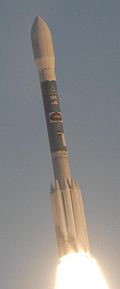
Rockets ThorThor · Thor-Able · Thor-Ablestar · Thor-Agena · Thor-Burner · Thor-Delta · Thor DSV-2 · Thor DSV-2U · Thorad-AgenaDeltaAlphabeticalNumericalDelta 0100 · Delta 1000 · Delta 2000 · Delta 3000 · Delta 4000 · Delta 5000 · Delta 6000 · Delta 7000 · Delta 8000 · Delta 9000ModernExportLaunch Sites LE-1 · LE-2OsakiBasesBardney · Breighton · Caistor · Carnaby · Catfoss · Coleby Grange · Driffield · Feltwell · Folkingham · Full Sutton · Harrington · Hemswell · Ludford Magna · Melton Mowbray · Mepal · North Luffenham · North Pickenham · Polebrook · Shepherds Grove · TuddenhamComponents BoostersFirst StagesUpper StagesDeltaOtherEnginesManufacturers RocketEnginesLaunches 1957–1959 · 1960–1969 · 1970–1979 · 1980–1989 · 1990–1999 · 2000–2009 · 2010–2019Categories:- Delta rockets
- Decatur, Alabama
- Decatur Metropolitan Area
- Huntsville–Decatur Combined Statistical Area
- Huntington Beach, California
- Boeing
Wikimedia Foundation. 2010.

